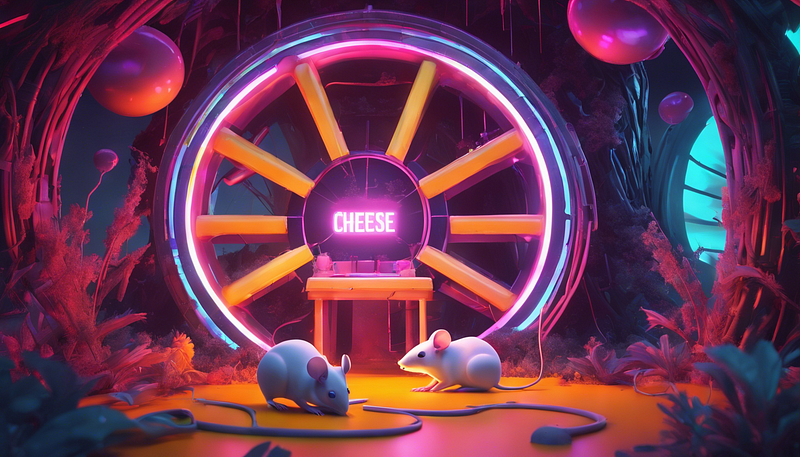Exploring the Future of VR: What It Means for Mice and Us
Written on
Understanding the VR Mice Study
Initially, I dismissed the notion of virtual reality (VR) being used on mice as just another quirky science experiment. However, a closer examination reveals a fascinating exploration that goes beyond mere whimsy.
Historically, humans have considered mice to be insignificant, timid creatures that merely scuttle around the periphery of our world. Yet, beneath their unassuming surface, they may hold profound insights into our understanding of reality itself.
The groundbreaking work of a dedicated team of scientists has led to the development of Miniature Rodent Stereo Illumination VR (iMRSIV)—a unique virtual reality platform designed specifically for these small mammals. By placing mice in rich, simulated environments, researchers can delve into the complexities of their neural processes like never before.

The Absurdity and Importance of VR for Mice
At first glance, the idea of mice exploring tiny virtual realms may seem laughable, akin to a scene from a Pixar movie. However, neuroscientists are leveraging VR to uncover critical insights into rodent brain function—knowledge that could ultimately benefit human understanding as well.
As a mouse navigates through a virtual landscape, scientists monitor its neural activity, constructing maps of the brain's circuits as they respond to various stimuli coded into the simulation. Each neuron becomes a vibrant star, illuminating the mouse's reactions to its surroundings.
By adjusting the software and observing neuronal responses, researchers can learn how the mouse’s brain interprets reality. This raises intriguing questions:
- What is the mouse experiencing as it dashes through these virtual corridors?
- Is it aware of its fabricated environment akin to Neo in the Matrix, or does it process the illusion subconsciously, like background noise?
Exploring the Mouse Mind
The very ability to pose such questions underscores our limited understanding of these commonly studied creatures. While we frequently investigate the mouse's cognitive processes for human benefit, we seldom consider how the world appears from their perspective.
Do they experience a thrill akin to bungee jumping when they encounter a reality distinct from their mundane existence in a cage? After tasting the fruits of technological advancements, can they ever perceive their captors—or themselves—differently?
The findings are significant: the brain seems unable to differentiate between actual and simulated experiences. Mice exhibit comparable neural patterns, regardless of whether they are navigating a physical maze or a virtual one.
This revelation leaves us pondering the potential to redefine our understanding of perception, memory, and consciousness.
The Broader Implications of VR
While the amusing image of lab mice donned in VR headsets makes the science approachable, it also prompts deeper inquiries:
- Can environments be crafted to specifically rewire the brain?
- If a virtual paradise feels real, does it count as reality?
- Have these mice unwittingly become participants in a form of Neuroscience Hunger Games?
If virtual environments can influence rodent perspectives, might the same apply to humans? What transformative applications and experiences await us in the future?
Furthermore, will our grasp of "truth" hinge on the latest neural technology?
If a small mouse can find fulfillment in escapism through virtual spaces, perhaps we humans share that same desire. Our craving for imagined realities is unquenchable.
Yet, the tangible world retains its allure. I suspect those test mice would concur, having lost themselves for hours in their miniature virtual realms. Even the grandest internal fantasies must occasionally yield to the simple joy of a delectable piece of cheese.
As we observe these mice navigating their VR adventures, they emerge as pioneers of perception and harbingers of future realities. Though the cheese may be a product of simulation, the implications for humanity are undeniably substantial.
In the flickering neurons and twitching whiskers of these mice, we catch a glimpse of our shared future—one where virtual experiences redefine the essence of consciousness. Ultimately, he who controls the cheese may well control the universe.
Chapter 1: The Role of VR in Neuroscience
In this video titled "He said I Couldn't Make a VR Game... So I Bought a VR Headset and Made One!" we explore the concept of creating immersive VR experiences, shedding light on the technological advancements that make such innovations possible.
Chapter 2: The Impact of Immersive Experiences
The second video, "THE STORY OF A TINY HERO! | Moss VR Gameplay + Giveaway (PSVR - PlayStation 4)," showcases how immersive gameplay can alter perceptions and experiences, similar to what is being explored in the mouse VR study.